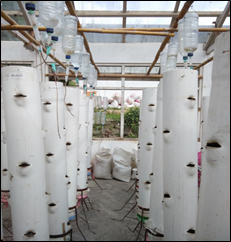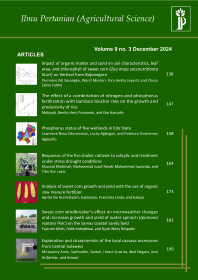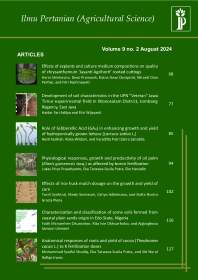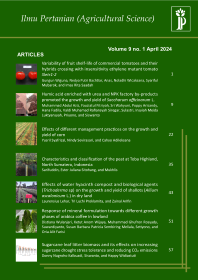
Water Use Efficiency in Vertical Cropping System with Volcanic Ash Media by Using Biochar and Urban Waste Compost Fertilizer as Soil Amendement
Mulyono Nitisapto(1*), Azwar Maas(2), Benito Heru Purwanto(3), Putu Sudira(4)
(1) Faculty of Agriculture Universitas Gadjah Mada, Yogyakarta
(2) Faculty of Agriculture Universitas Gadjah Mada, Yogyakarta
(3) Faculty of Agriculture Universitas Gadjah Mada, Yogyakarta
(4) Faculty of Agriculture Universitas Gadjah Mada, Yogyakarta
(*) Corresponding Author
Abstract
Applying volcanic ash as planting media has to cope with several constrains: it quickly became sediment and hardened when exposed to water. One of the efforts to improve its physical condition is by utilizing biochar, which is one of amendment materials that can improve the soil quality. This study used vertical column container made from PVC to enable vertical plant arrangement. Volcanic ash requires additional nutrient intake from organic fertilizer such as urban waste compost. The objective of this study was to identify the proper dose combination of volcanic ash, biochar, urban waste compost fertilizer and column population per m2 to sustain the growth of curly lettuce in vertical cropping system, as well as the water use efficiency. This study was designed by using the Completely Randomized Design (CRD) Factorial with three factors. The first, second and third factors consisted of Biochar M1, M2 and M3 (25; 33; and 50 %), compost fertilizer doses of K1, K2, and K3 (25; 33; and 50 %), and column density of P1, P2 and P3 (4 columns/m2, 3 columns/m2 and 2 columns/m2), respectively. The total combination was 3 x 3 x 3 and each was repeated 3 times. Resulted data of this study consisted of growth and crops and analyzed by using the Analysis of Variance and continued with the HSD Tukey 5% Test (Honest significant deference). The water use efficiency (g/kg) can be formulated as the production of dry material per total water during the cultivation season (g/kg). Results of this study showed the highest fresh consumption result was obtained from treatment M3K3 in 556 g/column (comparison of volcanic ash, charcoal husk and compost = 25 : 25 : 50 %) and the best water-use efficiency was 2.30 g/kg.
Keywords
Full Text:
PDFReferences
Afeng, Z., B. Rongjun. P. Genxing, C. Liqiang, H. Qaiser & L. Lianqing. 2012. Effects of biochar amendment on soil quality, crop yield and greenhouse gas emission in a Chinese rice paddy: A field study of 2 consecutive rice growing cycles. Field Crops Research, Elsevier. 127 (2012): 153–160.
Allyson, S. 2011. Biochar production for carbon sequestration. A Major Qualifying Project to Fac. WPI. Shanghai Jiao Tong University.
Barrow, C.J. 2012. Biochar: Potential for countering land degradation for improving agriculture. Applied Geography. Elsevier 34(2012): 21–28.
Bezerra, B.G. 2012. Crop evapotranspiration and water use efficiency National Institute of Semi-Arid (INSA) Brazil. Irrigation Systems and Practices in Challenging Environments.
Biswass, A.K. 1982. Applying systems analysis developing countries. Ceres 15 (6): 40-42.
Fak. Pertanian UGM, 1983. Peningkatan efisiensi pemanfaatan airpada tingkat usahatani. Prosiding Diskusi Panel UGM-DPU, 16-18Maret 1983.
Fiantis, D., 2006. Laju pelapukan kimia debu vulkanis gunung talang dan pengaruhnya terhadap proses pembentukan mineral liat Non-Kristalin. Universitas Andalas. Padang.
Lingga, P. dan Marsono. 2007. Petunjuk penggunaan pupuk. Penebar Swadaya. Jakarta.
Nasrullah, M. Dradjad & D. Prayitno, 1988. Teknologi produksi pertanian hemat lahan dan air. Makalah Lokakarya Pulang Kandang Alumni Fakultas Pertanian UGM, September 1988,38 h.
Nitisapto, M. 2018. Volcanic Ash Utilization as Planting Medium of Curly Lettuce with Charcoal Husk and Urban Waste Compost as Soil Amendment (Indonesian). Journal Aristech. Agric. Tech. Fac. Universitas Gajah Mada. Yogyakarta.
Rubatzky, V.E. and Yamaguchi, M. 1998. World vegetables: principles, production, and nutritive values, Second Edition (Sayuran Dunia: Prinsip, Produksi, dan Gizi, alih bahasa: Catur Herison) jilid 2. ITB, Bandung.
Sing, N.P. and Sinha, A. K. 1977. Water use efficiency in crop production. In : Water requirement and irrigation management of crop in India. Indian Agric Res Ins. New Delhi. 286-327.
Sinha, A. K. 1977. Soil - water relationship. Dalam : Water requirement and Irrigation management of crop in India. Indian Agric Res Ins. New Delhi. 9-56.
Sulistyawati, E dan R. Nugraha. 2012. Efektivitas kompos sampah perkotaan sebagai pupuk organik dalam meningkatan produktivitas dan menurunkan biaya produksi budidaya padi. Sekolah Ilmu dan teknologi Hayati. Institut Teknologi Bandung. Bandung.
Sumaryanto. 2005. Peningkatan efisiensi penggunaan air irigasi melalui penerapan iuran irigasi berbasis nilai ekonomi air irigasiI. Forum Penelitian Agro-Ekonomi, Vol 24 No2. h 77-91.
Zuraida. 1999. Penggunaan abu vulkan sebagai amelioran pada tanah gambut dan pengaruhnya terhadap sifat kimia tanah dan pertumbuhan jagung. Thesis dalam Program Pascasarjana Institut Pertanian Bogor.
Article Metrics
Refbacks
- There are currently no refbacks.
Ilmu Pertanian (Agricultural Science) ISSN 0126-4214 (print), ISSN 2527-7162 (online) is published by Faculty of Agriculture Universitas Gadjah Mada collaboration with Perhimpunan Sarjana Pertanian Indonesia (PISPI) and licensed under a Creative Commons Attribution-ShareAlike 4.0 International License.













